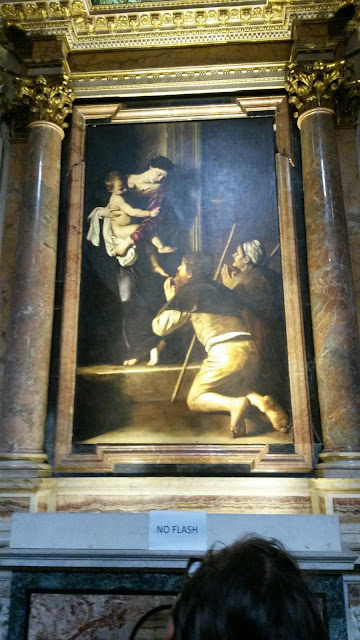Sorry about the lack of blogging. My last day in Rome was a very busy one. I'm sure you'll be happy to know that I made it home safe with absolutely no complications whatsoever. There were no delays on my plane ride, lost luggage, or anything else that would put a damper on my going home. Let me tell you, after such an amazing experience in a far away land, it's so nice to be back home. :)
Alright, so I hardly had time or energy to discuss what we saw on the last day of the program, but here goes. We saw Bernini's Ecstasy of St. Theresa, which was actually an artwork I've been wanting to see for a long time now. One of Bernini's greatest strengths was the fact that he could make his sculptures look alive. St. Theresa had a vision where an angel repeatedly pierced her with an arrow over and over again, though I have yet to read her writing on the experience myself, the professor described it as a very sensual recalling of the experience. Bernini was able to expertly make the statue look like nothing was supporting it, and the cloud the saint rested on really did look like a cloud. He also had the challenge of reflecting St. Theresa's possible emotions during the experience on her face as best as he could. It must have been a very difficult and limiting situation having to put a truly indescribable spiritual expression on an earthly medium. Unsurprisingly, his final product received scrutiny from protestants during the Reformation.
The last thing we saw was the Chiesa del Gesu (literally, Church of Jesus), which served as the birthplace and center of the Catholic Jesuit order for a very long time. The Jesuits have a code that prayer is meant to be used with all the senses, so church art, being able to use the sense of sight during meditation, was a necessity. Although, what was inside the church was truly something else entirely. There was an altarpiece of St. Ignatius, the founder of the Jesuit order, speaking with Jesus. Then our professor turned on the machinery, yes, machinery, involved in the altarpiece. Over speakers, there was a recording of a choir and an orator going through a Jesuit prayer exercise with light focusing on each statue and painting, then the painting was lowered to reveal a gold statue of St. Ignatius.
Now, apparently, this was ancient machinery, not a new thing, and the painting was put in storage several years ago until historians discovered the old machinery in the altarpiece. This raised a lot of questions for me, what caused the machinery to function? Has it always been in working order, or was it just recently repaired upon discovering the painting's purpose? How has it been preserved for so many years? Of course then I have to remember this is an art history course, not an engineering course. So, the main focus was basically how extravagant the piece was and would St. Ignatius have truly appreciated this.

































